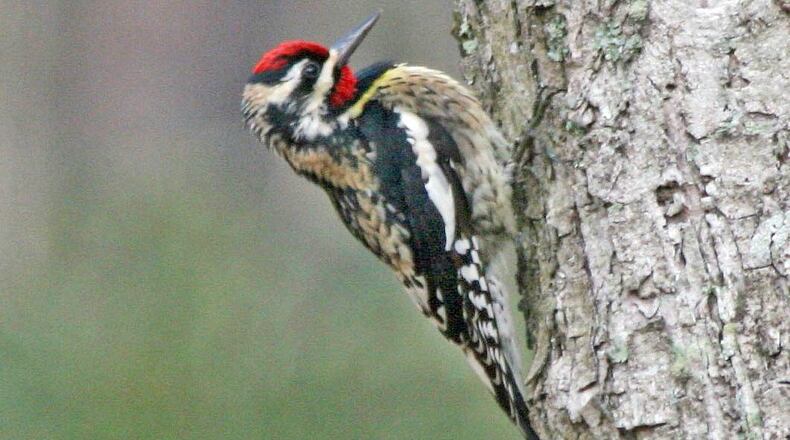A flash of red on the trunk of a tulip poplar just outside my office window in Decatur the other morning was from a yellow-bellied sapsucker — a confirmation that the bird has arrived from up north to spend the winter in Georgia.
The sapsucker, which sports a red crown and a red throat (if it’s a male), is eastern North America’s only truly migratory woodpecker, nesting up north during summer and flying south as far as Panama for the winter. A passel of them, though, travel no farther south than Georgia.
The sapsucker’s annual sojourn in Georgia makes the state home to eight woodpecker species during winter. The seven other species — pileated, red-bellied, red-headed, red-cockaded, downy and hairy woodpeckers and the northern flicker — are year-round residents. The red-cockaded, an endangered species, lives in small colonies in old-growth piney woods in South Georgia.
Winter, in fact, is the best time for watching woodpeckers. They mostly eat insects and insect larvae, but in winter, when insects are scarce, woodpeckers are apt to show up at backyard feeders more than at any other time of year — especially if the feeders offer suet, shelled peanuts and black oil sunflower seeds.
The most common woodpecker coming to wintertime feeders is the smallest, the little downy woodpecker — a sparrow-size, black-and-white bird (males have a distinctive red patch on the back of the head). The second most common winter visitor is the red-bellied, with a strikingly barred back and gleaming red cap.
The other woodpecker species also may visit feeders from time to time. A rare visit from Georgia’s largest woodpecker, the pileated, can be breathtaking.
The yellow-bellied sapsucker, besides being migratory, has another trait that makes it different from the other woodpeckers: It drills a series of deep, horizontal holes — “sap wells” — in tree trunks to drink the flowing sap. The sap wells also attract insects, which the sapsucker and other birds devour.
IN THE SKY: From David Dundee, retired Tellus Science Museum astronomer: The moon will be full on Thursday — the Cold Moon. It will be a “supermoon,” appearing brighter and larger than usual, according to Farmers’ Almanac. Just after dark, Jupiter rises in the east; Saturn is high in the south and appears near the moon Saturday. Mercury, Venus and Mars are not visible now.
Charles Seabrook can be reached at charles.seabrook@yahoo.com.
About the Author
Keep Reading
The Latest
Featured

